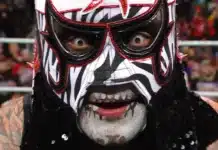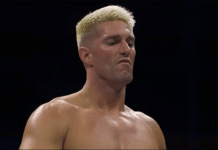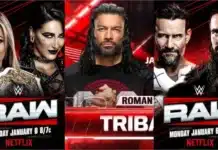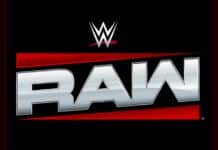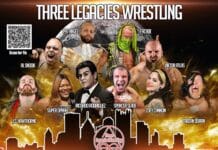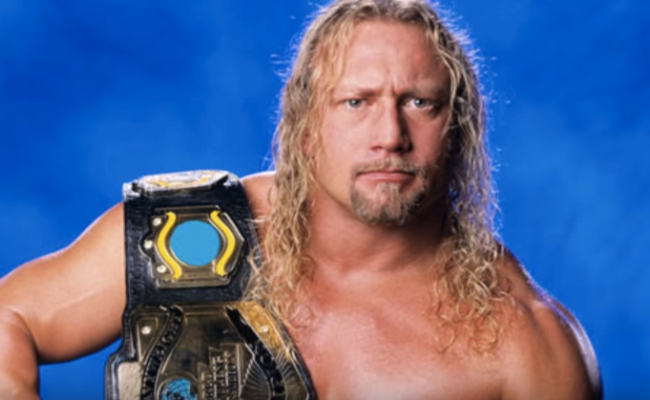
Just weeks after his second hip replacement surgery, a procedure brought on by more than two decades of top rope leg drops and pile drivers as signature moves, Jerry Lynn had the opportunity to reflect upon his accomplished 25-year career. The former ECW champion made the transition from a walker to a cane last week to aid in his recovery during physical therapy as he heals with another titanium replacement only 18 months after his initial hip repair. The grappler who often made his way to the ring to a chorus of heavy metal music quietly thumbed through paperwork during the healing process as he and his family plan to move into a new home on an acre lot in Nashville, TN.
However, the nearly half a dozen surgeries the veteran of the ring had weren’t a surprise, but rather a reminder of the words of his trainer, the Greco-Roman Olympian Brad Rhenigans nearly three decades ago. Rhenigans, a two-time Olympic amateur, and a Pan American gold medalist before his own notable career in the pro ranks, told a group of hopefuls that any significant time spent in the professional wrestling industry would require surgery at some point.
“I always trained hard, but even that doesn’t matter, really. It’s just the luck of the draw. How soon you need surgery or how soon you get hurt is the luck of the draw. You can get hurt hitting the ropes wrong, there are all kinds of risk when you step into that ring,” Lynn commented.
For Jerry Lynn, the Minnesota native discovered the sport like many others, through Saturday morning television as a youth when in-ring mayhem was complimented with episodes of roller derby each weekend. A natural athlete, he won a state and national amateur tournament his senior year of high school despite only one year of experience. A separated shoulder during his time at a community college ended his amateur run. But, attending an AWA event at a small ballroom in Minneapolis gave him some thought to another route to compete on the mat. Eventually, as he worked a job installing telephone cables, a friend told Jerry about Brad Rhenigans’ training center so the pair joined the class.
By 1988, a 25-year-old Lynn laced up his boots for his start inside the square circle of the AWA, the same group he watched on television on those roller derby weekends years earlier. Like most in their formative years, he honed his skills on smaller independent cards and an occasional TV appearance as an enhancement talent. A well-conditioned, but smaller athlete by the standards of the late-80s, Jerry found success through the fast-paced style often seen in Japan, and within a few years, he and fellow Minnesotan Sean Waltman led the way to introduce a new type of bout in the United States. Known as The Lighting Kid, Waltman and Lynn paired to bring a combination of several styles to deliver thrilling aerial bouts that were featured on the Global Wrestling Federation’s ESPN program and as far away as Japan, as crowds literally around the world witnessed the innovate contests in the early 90s.
“We’d watch tapes of anything we could get our hands on. Japanese, Mexican, and try to implement all the styles together in our matches. We didn’t really think about we’re going to revolutionize wrestling or change the way things are done or anything. I think we were just trying to make it fun for us, and a little more exciting for the fans,” Lynn explained.
The stellar series got both competitors noticed and opportunities for a bigger platform went their way. Waltman, who was one of the few lightweight athletes featured on the WWF roster at the time, had memorable moments on early episodes of Monday Night Raw to propel his career. On the flip side, Jerry landed his first major stage as the masked Mr. JL on the early editions of Nitro in 1995. Despite dozens of solid cruiser weight matches during his nearly two years on WCW TV, Lynn’s masked persona was never given a meaningful direction and was often relegated to secondary television shows as an enhancement talent.
“They didn’t have plans for me. It didn’t matter how well I wrestled, I was just time filler. I was just a small fish. They had the big guns, the NWO going on,” Lynn said of his run in the Ted Turner organization.
When his WCW contract wasn’t renewed, it took just a few months for Jerry to get started in Paul Heyman’s Extreme Championship Wrestling in late-1997. The renegade promotion went on to revolutionize the presentation of the genre in America, but when Jerry arrived, the extreme group only had two pay-per-view broadcasts at that point so for the first time in his career, Lynn had the chance to be featured in a major spot of a company that was building a buzz. Heyman’s brilliant mind was always able to find underutilized talent and give them their rightful platform, which was certainly the case for Jerry as his profile was elevated significantly during his run in ECW, but even Lynn had to find himself as a performer there.
“It was timing, it was more freedom to do what I wanted in the ring. When I got to ECW, it was hard at first because I’d try to be creative to come up with table spots and stuff so it didn’t look like a rearrange the furniture match, and I’d always get shot down. Finally, at the ECW Arena against Justin Incredible, we were having a two out of three falls match and I told him before the show we’re not going to ask permission for anything. We’re just going to go out there and do what we do, and that’s the night things changed.”
That night at ECW’s A Matter of Respect event in mid-1998 at the dingy bingo hall in south Philadelphia where so many memorable moments happened, Lynn and Justin Credible saw the culmination of their rivalry, a series of matches that started around the time both began their ECW careers nearly eight months earlier. Jerry’s status was elevated, and his ability to deliver consistently solid performances moved him further up the card. As was the case throughout his career, Lynn could have great matches with anyone, and the potential the WCW completely overlooked was given the spotlight in the hardcore promotion. The diehard fan base praised stellar bouts against the underrated Lance Storm, Guido, and others. However, it was Lynn’s innovative and influential series of contests against Rob Van Dam that remain some of the most talked about matches in the promotion’s history. In fact, the RVD/Lynn bouts in 1999 were often considered the best in-ring action in the industry during a time when the business had surged in popularity. As great as those moments were and in some ways helped define the career Jerry had, he also paid a price for the physical toll those hard-hitting matches took on his body.
“In ECW was actually when I realized the business was going to change and if you wanted to survive, you have to be willing to change along with it. I realized I was going to get hit in the head with that cane 100 times or use a table, but I didn’t take a chair shot to the head. Even though there weren’t concussion studies back then, I had rang my bell a few times just from hitting the mat if you don’t get to tuck your chin,” he said.
Goat table spot pic.twitter.com/JUDc9GalFX
— ill dill (@backlund94) January 16, 2019
Rob Van Dam was in the midst of a record-setting TV title reign, and Jerry Lynn was presented as the competitor that could take “Mr. Monday Night” to the limit each time they stepped into the ring. Lynn was one of the few that could keep pace with “The Whole F’N Show,” a moniker that the confident champion gave himself. As a result of their close contests, the fans gave Jerry the moniker of “The New F’N Show” as a sign of respect for his efforts in the TV title picture.
“The fans are what made ECW, they were a part of the show and they were there to have a good time,” Jerry said.
After a very successful 1999 for Jerry Lynn, the well-documented pressure of the competition in the industry, including the infamous TNN deal, put the future of the company in jeopardy. In October of 2000, in his home state of Minnesota, he defeated Justin Credible to win the ECW Heavyweight championship at the Anarchy Rulz pay-per-view. After 12 years of being one of the most well-rounded wrestlers in the sport, an often-overlooked Jerry Lynn finally got the recognition he deserved as his in-ring ability definitely was at a main event level. Unfortunately, ECW collapsed just three months later, but the company is still fondly remembered by both wrestlers and fans.
“That’s why a lot of us stayed there when the checks were bouncing because we were having fun. It wasn’t like a job where you wake up everyday and say that you don’t want to go to work today. It was fun so we invested a lot of blood, sweat, and tears into the company to get going, hoping something would break so we weren’t going to give up”
Still fresh from his notoriety in ECW, Lynn was offered a WWF contract and had a six-month stint there, winning the Light Heavyweight belt. A knee injury put him on the shelf while Vince McMahon’s acquisition of WCW flooded the roster with several names so he got lost in the shuffle before his departure. When his knee healed, aside from working the independent scene, Jerry was a part of several of the early NWA-TNA events, working a six man tag that was the first official match in the company’s history. As the X-Division got TNA noticed, Lynn played an important role as his matches with AJ Styles, Low Ki, and others were one of the reasons the X-Division was popularized. Similar to his bouts with RVD, Lynn’s work in the X-Division also had an impact on the athletes in the years that followed.
Despite a few solid years under the TNA banner, Lynn felt he was typecast in a secondary role there and opted for the flexibility of the independent scene, but made an occasional TNA return over the years. Along with dozens of independent groups, Jerry had a run in Ring Of Honor, winning their championship for a brief time in 2009. Finally, after 25 years as an in-ring competitor, Jerry decided to hang up the boots when he competed for his retirement match in his hometown in 2013.
“It was hard, I went through a depression. Over 24 years of doing something you love, it was hard at first, but once you get over it, it was fine,” he explained.
Today, Jerry works an office job at a medical supply company and enjoys spending time with his family. While his oldest daughter is 25 and still lives in Minnesota, the man that once put Rob Van Dam through a table on pay-per-view looks forward to taking his 12-year-old daughter, Annabelle to band activities for school. Still retired, Lynn did return to the ring as a referee for the All-in event that Cody and The Young Bucks put together last year, which he cited as the only time he wished he still wrestled. Regardless of being done in the ring, Jerry still follows the industry, and his podcast “Front Row Material” with another ECW alumni, Mikey Whipwreck can be found on the MLW podcast network.
"Is this the real life? Is this just fantasy? Caught in a landslide…" HOLY SHIT, WE'RE ON .@MLW FINALLY!
Our DEBUT MLW Episode is now live: https://t.co/l5a6ZbBDeQ
iTunes – https://t.co/9tQmNmNUjt
Spotify – https://t.co/gD5Lkcpjx6Front Row Material: It's Not For Everyone! pic.twitter.com/YcpetkkuOY
— Front Row Material ™️ (@FRMpod) February 6, 2019
Perhaps, Jerry Lynn didn’t truly get the credit that he deserved for his tremendous ability over the span of two and a half decades, but his resume highlights his skills, as he’s one of the few wrestlers that worked for every major company in the United States in the modern era. More specifically, you simply won’t find a subpar Jerry Lynn match, which puts him in a category with underrated legends such as Lance Storm, Bobby Eaton, and Chris Hamrick. Undoubtedly, Jerry Lynn earned the respect of fans and his peers during a legendary career.
You can follow Jerry on Twitter @itsjerrylynn
You can find his t-shirt store online https://www.prowrestlingtees.com/jerrylynn
You can listen to his podcast frmpod.com
What do you think? Comment below with your thoughts, opinions, feedback and anything else that was raised.
Until next week
-Jim LaMotta
E mail [email protected] | You can follow me on Twitter @jimlamotta

